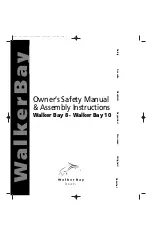
30
Overtaking
Other
Navigational Situations
There are a few other situations in which you should be aware of when navigating on
open waters.
When navigating in narrow channels, you should keep to the right when it is safe and
practical to do so. If the boat operator preparing to go around a bend that may ob-
struct the view of other vessels, the operator should sound a prolonged blast (four to
six seconds) of a whistle or horn. If another vessel is around the bend, it too should
sound the whistle or horn.
Fishing vessels have the right-of-way, regardless of position, but they cannot im-
peded the passage of other vessels in narrow channels. A vessel is considered a
fishing vessel if it is fishing with nets, lines or trawls; however boats with trolling lines
are not considered fishing vessels.
Sailing vessels should also normally be given the right-of-way. The exceptions to
this are:
•
When the sailing vessel is overtaking the power-driven vessel, the power
driven vessel has the right-of-way.
•
Sailing vessels should keep clear of any fishing vessel
•
In a narrow channel, a sailing vessel should not hamper the safe passage of a
power-driven vessel, which can navigate only in such a channel.
Navigational Markings
The waters of the United States and its territories are marked to assist navigation by
the United States Aids to Navigation System. The system employs a simple arrange-
ment of colors, shapes, sizes, numbers and light characteristics to mark navigable
channels, waterways and obstructions adjacent to these.
Official waterway markers may be in the form of a buoy, sign or light, either in the wa-
ter or on shore. These markings assist the boater by marking channels, denoting
unsafe areas, directing traffic, controlling speed, protecting resources and other func-
tions.
Regulatory Markers
Regulatory markers are used to alert boaters of various warnings and regulatory mat-
ters. Regulatory markers are white cans with black letters and have orange warning
borders in different shapes.
Summary of Contents for GTS 20 2015
Page 1: ...Owner s Manual 2015...
Page 7: ...1 Safety...
Page 21: ...Hazardous Boating Conditions 2...
Page 24: ...3 Emergencies...
Page 29: ...4 Boating Regulations...
Page 33: ...5 Navigational Rules...
Page 38: ...6 Model Guide...
Page 43: ...7 Boat Features Options...
Page 54: ...8 Operation...
Page 60: ...9 Maintenance Care...
Page 69: ...10 Winterization Storage...
Page 73: ...67...
Page 74: ...11 Trailering Launching...
Page 83: ...12 Warranty...
















































